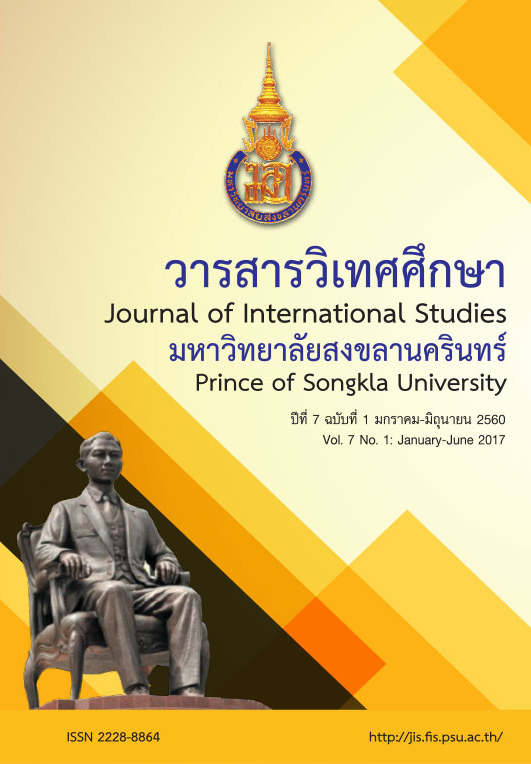The Sino-Yugoslav Conflict in Three Contexts: The Soviet Union, the Afro-Asian Nations and Mao Zedong’s Continuous Revolution
Main Article Content
Abstract
Although China and Yugoslavia had established diplomatic relations in 1955, the relations between the two socialist states deteriorated soon afterward. By 1958, Yugoslavia was condemned by China as “revisionism.” The article aims to explore the Sino-Yugoslav conflict lasting from the late 1950s to the end of the 1960s through three contexts: the Sino-Soviet conflict; the Sino-Yugoslav competition for friendship among Afro-Asian nations; and Mao Zedong’s strive for “continuous revolution” inside his country, which led to the radicalization of Chinese foreign policy.
Article Details
Statements and opinions expressed in articles herein are those of the authors and do not necessarily reflect the position of the editors or publisher.
Article, information, text, image, etc. which are published in Journal of International Studies, belong to Journal of International Studies. If anybody or any organization would like to use part or whole of them, they must receive written permission from Journal of International Studies before usage.
References
จางเหมี่ยนลี่. (2006). จงกั๋วอวี่หนานซือลาฟูเจี้ยนเจียวสื่อม่อ (กระบวนการสถาปนาความสัมพันธ์ทางการทูตระหว่างจีนกับยูโกสลาเวีย). ตางไต้จงกั๋วสื่อเหยียนจิว วารสารประวัติศาสตร์จีนร่วมสมัยศึกษา 13 (3), 93-100.
โจวว่าน. (2010). อวี่จงซูเจิงตั๋วตี้ซานซื้อเจี้ย: อีจิ่วอู่ปาเต้าอีจิ่วอู๋จิ่วเหนียนเถี่ยทัวเตอะย่าเฟยจือสิง (การแข่งขันกับจีนและโซเวียตในโลกที่สาม: การเดินทางเยือนเอเชียและแอฟริกาของติโตช่วง ค.ศ. 1958 – 1959). ใน เหลิ่งจ้านกั๋วจี้สื่อเหยียนจิว จิ่ว (วิจัยประวัติศาสตร์ความสัมพันธ์ระหว่างประเทศในยุคสงครามเย็น เล่มที่เก้า), บรรณาธิการโดย หลี่ตานฮุ่ย, หน้า 71-106. เป่ยจิง: ซื่อเจี้ยจือซื่อชูป่านเส้อ.
ประทุมพร วัชรเสถียร. (2527). พฤติกรรมความสัมพันธ์ระหว่าง ประเทศของยุโรปตะวันออก: ปัญหาและการวิเคราะห์. กรุงเทพมหานคร: ไทยวัฒนาพานิช.
Biberaj, Elez. (1985). “Albania and China 1962-1978: A Case Study of a Bilateral Unequal Alliance.” Ph.D. Dissertation, Columbia University.
Chen Jian. (2001). Mao’s China and the Cold War. Chapel Hill, NC: The University of North Carolina Press.
Cheng, Peter. (1972). A Chronology of the People’s Republic of China from October 1, 1949. Totowa, NJ: Littlefield, Adams & Co.
“General Introduction.” (1965). In Communist China 1955-1959: Policy Documents with Analysis, with a foreword by Robert R. Bowie and John K. Fairbank. Cambridge, MA: Harvard University Press.
Hu Sheng. (1994). A Concise History of the Communist Party of China. Beijing: Foreign Languages Press.“Is Yugoslavia a Socialist Country? -- Comment on the Open Letter of the Central Committee of the CPSU (III) by the Editorial Departments of Renmin Ribao (People’s Daily) and Hongqi (Red Flag).” (26 September 1963). Available from https://www.marxists.org/history/international/comintern/sino-soviet-split/cpc/yugoslavia.htm, accessed 4 October 2015.
Johnson, Chalmers A. (1962). Peasant Nationalism and Communist Power: The Emergence of Revolutionary China 1937-1945. Stanford, CA: Stanford University Press.
MacFarquhar, Roderick. (1974). The Origins of the Cultural Revolution 1: Contradictions among the People 1956-1957. New York: Columbia University Press.
MacFarquhar, Roderick. (1983). The Origins of the Cultural Revolution 2: The Great Leap Forward 1958-1960. New York: Columbia University Press.
MacFarquhar, Roderick. (1997). The Origins of the Cultural Revolution 3: The Coming of the Cataclysm 1961-1963. New York: Columbia University Press.
Mao Zedong. (1957). "Talks at a Conference of Secretaries of Provincial, Municipal, and Autonomous Region Party Committees, January 1957.” Available from https://www.marxists.org/reference/archive/mao/elected-works/volume-5/mswv5_57.htm, accessed 5 October 2015.
Mao Zedong. (1998). On Diplomacy. Beijing: Foreign Languages Press. “On Krushchov’s Phoney Communism and Its Historical Lessons for the World -- Comment on the Open Letter of the Central Committee of the CPSU (IX) by the Editorial Departments of Renmin Ribao (People’s Daily) and Hongqi (Red Flag).”(14 July 1964). Available fromhttp://www.marx2mao.com/Other/KPC64.html, accessed 5 October 2015.
Peking Review. (1959, March 24). Available from http://www.massline.org/PekingReview/, accessed 5 October 2015.
Peking Review. (1961, September 15). Available from http://www.massline.org/PekingReview/, accessed 5 October 2015.
Peking Review. (1963, May 17). Available from http://www.massline.org/PekingReview/, accessed 5 October 2015.
Petkovic, Ranko. (1976). Tito on Non-Alignment. Belgrade: Federal Committee for Information and Jugoslavenska Stvarnost –Medunarodna Politika.
Reill, Dominique Kirchner. (2014). “Partisan legacies and anti-imperialist ambitions: the Little Red Book in Italy and Yugoslavia.” In Mao’s Little Red Book: A Global History, ed. Alexander C. Cook, pp. 185-205. Cambridge:
Cambridge University Press.
“Resolution on the Moscow Meetings of Representatives of the Communist and Workers’ Parties, adopted May 23, 1958, by the Second Session of the Eighth Party Congress of the Chinese Communist Party.” In Communist China 1955-1959: Policy Documents with Analysis, with a foreword by Robert R. Bowie
and John K. Fairbank, pp. 405-415. Cambridge, MA: Harvard University Press, 1965.
Rubinstein, Alvin Z. (1970). Yugoslavia and the Nonaligned World. Princeton, NJ: Princeton University Press.
Smith, Tony. (2000). “New Bottles for New Wine: A Pericentric Framework for the Study of the Cold War.” Diplomatic History, 24 (4), 567-591.
Whiting, Allan S. (1987). “The Sino-Soviet Split.” In The Cambridge History of China Volume 14 the People’s Republic, Part I: The Emergence of Revolutionary China 1949-1965, eds. RoderickMacFarquhar and John K. Fairbank, pp. 478-538. New York: Cambridge University Press.
Wu Xiuquan. (1985). Eight Years in the Ministry of Foreign Affairs (January 1950 - October 1958) – Memoirs of a Diplomat. Beijing: New World Press.
Zubok, Vladislav and Constantine Pleshakov. (1996). Inside the Kremlin’s Cold War: From Stalin to Khrushchev. Cambridge, MA: Harvard University Press.


